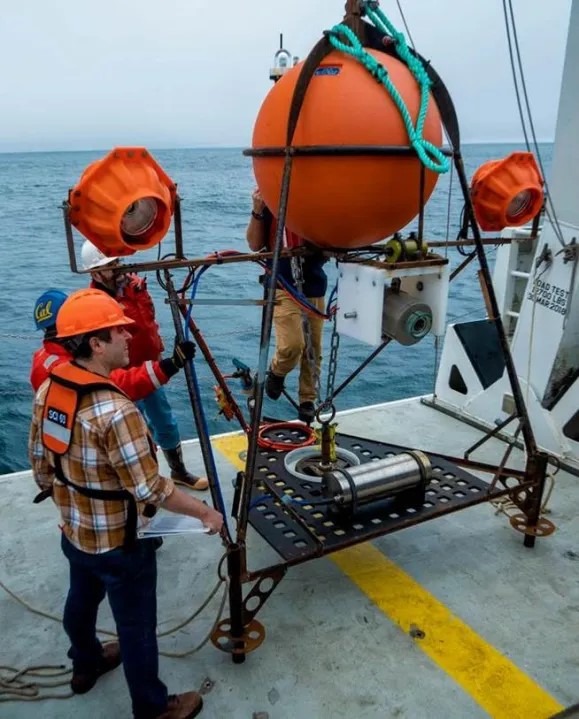
Blog: Finding Sanctuary – Discovery, protection of ancient coral gardens in our backyard By: Lisa Wooninck
Blog: Finding Sanctuary – Discovery, protection of ancient coral gardens in our backyard By: Lisa Wooninck

The Coralcam takes pictures of corals through time at 4,000 feet deep. (Jim Barry, MBARI/Contributed)
By: Lisa Wooninck
Published: Santa Cruz Sentinel, March 16, 2024
Plastic pollution on land and in the ocean is a problem, because unlike biodegradable or reusable materials (e.g., plants, paper, glass), plastic persists. After World War II, demand for plastic skyrocketed, particularly for public consumption, because plastic is versatile, sanitary, and cheap and easy to manufacture.
Plastics are made up of multiple synthetic compounds that can persist and accumulate in the environment for multiple decades to centuries. Plastic bags are estimated to take up to 1,000 years to break down in a landfill. Pam Krone, water quality specialist for Monterey Bay National Marine Sanctuary and the California Marine Sanctuary Foundation (CMSF) recently conducted a study that found that two-thirds of beach litter along the shoreline of the sanctuary is composed of plastic. The primary sources are plastics associated with eating and smoking.
Microplastics are also of great concern. Plastics are extremely durable and resilient to decomposition, they break apart into smaller pieces, creating microplastics. Pieces larger than 5 millimeters (mm) are macroplastics, smaller than 5 mm are microplastics, and smaller yet, less than 1 micron are nanoplastics.
A paper published by the Monterey Bay Aquarium Research Institute in 2019 showed that microplastics were found in filter-feeding organisms at multiple depths in Monterey Bay. “The fact that microplastics have been found in every surface water sample and as deep as 1,000 meters suggests that no part of our sanctuary is untouched by microplastics”, says sanctuary research ecologist Chad King.
Macro- to nanoplastics may become part of the food chain, as they are mistaken for food and ingested by plankton, birds, and fish, causing malnutrition, gut blockages, or in some cases, toxicity to organisms. According to Matt Savoca (CMSF), “We’ve estimated that humpback whales ingest 200,000 pieces of microplastics a day and blue whales 10 million pieces. We don’t know yet how these microplastics may travel through the whale’s body or whether they can cause damage by traversing into the bloodstream. We do know that the sharp edges of microplastics can damage sensitive membranes in the digestive systems of birds, mussels, and crabs.” Human health is also at risk from microplastics. Savoca says, “We know that tiny plastics are everywhere, but we know less about the sources and sinks of this debris, the impacts to humans and wildlife, and the thresholds that cause negative effects.”
Tackling this issue are Savoca, Krone, and King in partnership with the Moore Institute of Plastic Pollution Research, and Hopkins Marine Station. This team is conducting a study entitled, “From Watershed to Whales: Tracking the Source and Transport of Microplastics in the Greater Monterey Bay Region to Inform Risk Assessments.” According to Savoca, “We are assessing the quantity of different size classes of microplastics in different environments so that we might in the future better understand the various risks to marine life and human health.”
This team is monitoring and analyzing microplastic samples collected from local beach sand, the ocean, and fish to assess the chemical footprint of plastics from these environments. They are also collecting water samples from local rivers to better quantify the amount and source of plastic that enters the ocean, because much of plastic that makes its way into the ocean travels down watersheds. Understanding the sources of microplastics will inform future efforts to reduce or eliminate the transport of plastic into the sanctuary.
You can do your part to help reduce the amount of plastic that enters the sanctuary: avoid buying and using single-use plastic (e.g., water bottles, straws, and plastic bags), or participate in beach or river cleanups.
Lisa Wooninck became the superintendent of NOAA’s Monterey Bay National Marine Sanctuary in 2021. She has a doctorate in ecology and evolutionary biology, and marine biology from UC Santa Barbara. She can be reached at lisa.wooninck@noaa.gov. To learn more about the sanctuary, visit https://montereybay.noaa.gov/.
